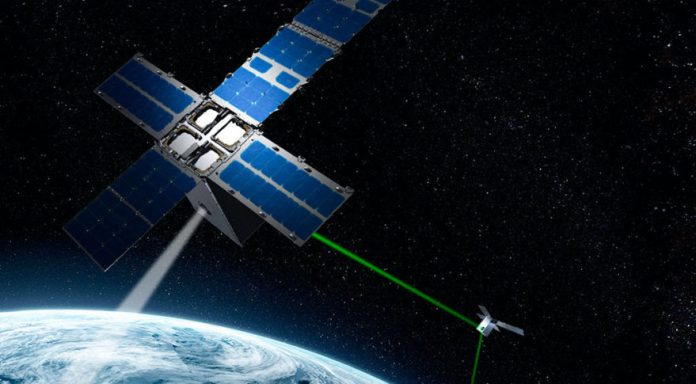The Space Development Agency says optical inter-satellite links are”one of the most vital technologies to be shown.”
WASHINGTON communications terminals that use lasers to beam data across space will be tested in upcoming experiments by the Space Development Agency and the Defense Advanced Research Projects Agency.
These terminals are important pieces of DoD’s future Earth orbit constellations which will require crosslinks so data could be delivered to military command centers around the ground. Laser communications systems have considerably faster data transmission rates whether the electronics can withstand the stress of space launching and compared to systems but DoD has issues such as the effects of space radiation on terminals.
“Optical inter-satellite connections are one of the most critical technologies necessary to be shown for Tranche 0,” that the Space Development Agency stated in a request for proposals issued for its communications constellation known at the transport layer. Tranche 0 is the deployment.
The satellites in the transport layer need to pass data in space and down to army users with low latency to the ground. That can’t happen”with no demonstration along with maturation of optical inter-satellite crosslinks — with radio frequency (RF) crosslinks as a backup,” that the SDA petition states. One of many concerns of using lasers for downlinks is entering the Earth’s atmosphere, especially.
SDA wants to build one or more constellations of hundreds of satellites for missile monitoring and for communications. So that it’s requesting bidders to make sure that their hardware is interoperable with many other sellers, it plans to purchase optical terminals.
Businesses follow standards that are common and produce advanced optical terminals because of NASA calling. However, there’s no recognized industry standard for optical inter-satellite links in orbits below geosynchronous selection, according to SDA.
SDA added a standard to earn connections interoperable but it will need providers to collaborate to be certain their systems are compatible.
One of the companies currently working using SDA on connections is General Atomics Electromagnetic Systems. GA-EMS announced on June 5 that it signed an agreement with the bureau to conduct a series of experiments for optical inter-satellite links utilizing the organization’s laser communication terminals.
“These experiments could show strong communication skills through multiple mediums, both from Earth, to and between satellites from numerous orbits, and in to deep space,” Scott Forney, president of GA-EMS, said in a statement.
For the experiment scheduled to launch in March 2021, the business will create two 12U cubesats, every hosting also an laser communications terminal along with an infrared payload.
Another closely watched demonstration is the Blackjack app of DARPA. The bureau next year plans to launch a set of small satellites that will carry optical inter-satellite connections. At the conclusion of this Blackjack app in 2022, DARPA’s objective is to show an optically meshed network in LEO can provide global secure communications to the U.S. army.
Space Micro, a company that provides space electronics to NASA and DoD, obtained an Air Force contract to develop a secure optical terminal.
CEO David Strobel told SpaceNews the SDA and DARPA programs will challenge the business to make little terminals that can meet demanding performance goals.
DoD has a very different requirements than NASA applications that attempt to set up communications using the moon and beyond. “NASA has proved that the technology. However, their terminals are not cheap for LEO apps”
A vital benefit of laser connections is they are really secure, said Strobel. “They’re nearly impossible to intercept”
Laser communications strategy. Charge: the Blackjack program was started by CACIBefore DARPA it given a contract to create two little laser communication terminals to be utilized as connections to LGS Innovations in 2016.
LGS Innovations possessed by CACI International, delivered DARPA and the terminals plans to launch them in a future space experimentation, Chris Simi, software manager at DARPA’s Strategic Technology Office, informed SpaceNews.
Tom Wood, the senior manager for optical communications and social media of CACI, said the firm was operating on this technology for over 20 years.
CACI is building a laser transmitter for NASA’s Deep Space Optical Communications project to bring data from an asteroid back to Earth.
Laser-based communications are”starting to get a whole lot of grip,” he advised SpaceNews.
There are still a few problems that will need to be solved, he said. “We have to work through the risks with optical components such as the way they function in radiation”
Wood said calling is currently bringing more interest due to the challenges and constraints of RF techniques,” stated Wood. “The manner engineers have addressed it in the past 15 years is by going to higher frequencies.
The spectrum is in supply whereas the spectrum that is available is much greater in the optical ring. “It’s roughly 8,000 gigahertz,” said Wood. “You may become basically infinite spectrum for transmissions. And you can become higher throughput through optical systems than through radio programs,” he added. “This spectrum is unlicensed by the Federal Communications Commission or other governments. You can build your equipment and move.”
– Advertisement –
